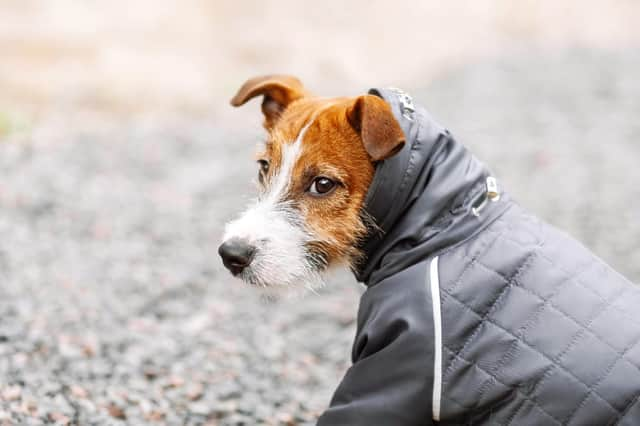Emergency vets are warning owners over winter weather - how to keep your pet safe


Temperatures have plummeted across the UK, and the Met Office has forecast wintry conditions, including snow, ice and sleet, over the next fews days.
However, colder weather doesn’t just take its toll on humans, as extreme wintry weather can also pose a risk to pets.
Advertisement
Hide AdAdvertisement
Hide AdEmergency vet service, Vets Now, has seen a rise in cold weather-related cases in its animal hospital and clinics, with frost, fog, snow and high winds affecting pets.
Common issues emergency vets will treat include cats and dogs suffering from frostbite on paws, breathing difficulties from dogs who have short-noses, and pets injuring themselves due to icy and slippery surfaces or injuries on snow-covered hazards, such as rocks.
Vets Now head of telehealth, Dave Leicester, said: “Heavy snowfall and freezing temperatures pose a serious threat to your pet.”
How to keep your pet safe and warm during wintry weather
Here, Mr Leicester advises ways to help you protect your pet and prevent unwanted illness or injury during the colder weather.
If it’s too cold for you, it’s too cold for your pet
Advertisement
Hide AdAdvertisement
Hide AdYou should try to keep your pets inside, especially overnight when temperatures drop, otherwise they run the risk of getting frostbite or hypothermia.
“If your pet is showing signs of either of these, contact your vet immediately,” explains Mr Leicester.
However, temperatures indoors can also plummet, so if you’re out, try to make sure temperatures in your home can never fall below a reasonable level (around 20C).
Go on shorter, more frequent walks
Consider taking your dog on shorter, more frequent walks in order to protect them from weather-associated health risks, rather than long walks in the cold.
Wash and dry your pet’s feet following walks
Advertisement
Hide AdAdvertisement
Hide AdSalt and chemicals that are used to grit roads and pavements can irritate your pet’s pads, especially if they have any small cracks or redness between the toes.
Always wipe your pet's paws with a cloth and warm water when they come back inside.
Don’t let your pet fall victim to antifreeze
Antifreeze poisoning is a major hazard during cold weather snaps, especially if it leaks from a car’s radiator or spills on the ground while being sprayed on frozen car windows.
If possible, remove ice from vehicles using an old-fashioned scraper. Keep containers of antifreeze locked away and clean up any spills quickly, “as even small amounts can be deadly,” Mr Leicester adds.
Keep a close eye on your car
Advertisement
Hide AdAdvertisement
Hide AdCats who are allowed outside during cold spells may try to cosy up on a warm vehicle engine, so check underneath your car and bang on the bonnet before starting your engine.
Research your pet’s breed
Some pets, such as husky dogs and Persian cats, are more tolerant to colder weather than others.
Do your homework on your pet’s breed, as some dog breeds, including dobermans, chihuahuas and great danes, require a little extra protection in the cold.
Short-nosed pets are also more at risk from extreme temperatures due to inherited breathing difficulties.
Advertisement
Hide AdAdvertisement
Hide AdShort-nosed dogs are also particularly at risk of suffering heat stroke if they exercise vigorously in freezing temperatures and then settle in a warm house.
Consider a jumper or coat
Consider putting a dry sweater or coat on your pet before going outside and always take spares in case they get wet.
Make sure your pet is wearing a collar and is microchipped
Pets are more at risk of becoming lost and disoriented in snowy or blizzard conditions, so ensure your dog or cat’s identification tag and microchip details are up to date.
Avoid icy lakes and ponds
Stay clear of water that has frozen over, as there is no guarantee it will support the weight of your pet.
Advertisement
Hide AdAdvertisement
Hide Ad“If your dog or cat falls through ice it may be deadly,” says Mr Leicester.
Feed your pets well
Pets who spend long periods outside may require more calories during the winter months in order to generate enough energy to keep them warm. Talk to your vet about your pet’s nutritional needs - but don’t overfeed them.
Watch out for icy steps, roads and pavements
Older pets, particularly those with arthritis or mobility issues, are at risk of slipping and injuring themselves on slippery surfaces, especially on steps or when jumping in or out of vehicles.
Make sure your pet has access to fresh water
Make sure you check your pet’s water bowl regularly and fill it up whenever it’s low. You should also be careful not to let your pet’s water bowl freeze over.
Beware of hazards covered in snow
Advertisement
Hide AdAdvertisement
Hide AdSome pets may injure themselves by falling into potholes covered in snow or from crashing into rocks and steps that they can’t see, so it’s worth being aware of these hazards.
Be prepared for cold weather
If the weather forecasters predict an extreme cold snap or snow and blizzards, make sure you have a pet emergency plan in place.
“This includes stocking up on food and any prescription medication, knowing who to call in an emergency and how you might travel to the vet in an emergency,” Mr Leicester adds.